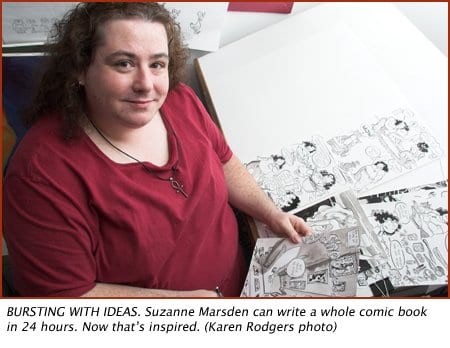***
Artist Suzanne Marsden produces a page an hour, hands moving fast, whipping together drawings of herself, her friends and pets facing dragons, wishing wells and superheroes, all in urgent, fantastical moments with cryptic captions dashed above.
It is what she does when she is stuck. Or bored. Or in the mood for a 24-hour comic marathon.
I watched her draw on a scrap of paper. Quickly, easily, she drew herself — unruly locks on a freckled face, a frumpy loose-fitting shirt and her beer held high, toasting me with a grin, “Cheers!”
It is an easy to see that the image is her. She draws herself with affection and self-awareness.
“Everyone who draws has a need to tell their stories.” Marsden smiles, “It’s the way we keep our sanity.”
Marsden currently enjoys the stability of a gig as a publishing assistant at Statistics Canada. But this is a new venture. Most of her working career has been in the animation world, working for studios in Ottawa and Toronto, on character design.
“Working in studio is such a laugh if you’re in animation. You draw characters all morning, go for lunch, come back and draw. And you’re surrounded by people who are just like you. It’s a inspiring space to be in.”
Inspiring, yes. But stable, no. Marsden jokes about the fun-filled days of working in animation and losing her job regularly.
“At the time, in animation, you’d work five months of the year then you get laid off. But you’d have made enough to survive the other months. We used to joke that you didn’t get vacation, you just got laid-off.”
Technology posed an even bigger challenge, something that Marsden decided not to fight.
“Computers changed everything. People like myself, pen-and-paper drawers struggled with the transition to computers. There were kids coming out of college, drawing with the various programs but working for peanuts. It made sense to find something stable and go back to drawing for myself.”
Running Dragonhead Studio is what Marsden now does on the side. It just so happens that there are many waiting for her comics. Her comics tend to follow an autobiographical indie-zine style, featuring herself as her main character.
“I think part of drawing myself is having a comfortable character that I can use for story-telling. What character do you know better than yourself? Besides, as you can imagine, it could be pretty awkward with some stories to tell it completely straight with a character who is you and your friends who are so obviously your friends.”
There’s something endearing about Marsden’s art, with strains of humour and humility together with a ‘go get ’em!’ attitude. Marsden’s stories range from the day-to-day to the tougher stuff, like coming out the closet.
“It’s always been handy having drawing as my direction. It helped me work through things and kept me in touch with creative people. It’s been my safety net.”
Marsden came out in her twenties through her personal comic. Rather than take the slow but sure route of sharing her orientation only when asked, or when it came up, Marsden put together a “coming out issue.” There were hints all over that particular issue, and if the obvious passed the reader by, there was an announcement in the writer’s notes.
“It was a neat way to do it. I needed to come out like that. The process of creating that issue helped me think things through. And in the end, sharing that was a celebration.”
Together with Abraxia, which Marsden publishes regularly, she is also working on a book. Called “96-hours,” it consists of four 24-hour comics. These have been created in a space from noon to noon, and contain all the silliness and profound epiphanies that one would expect from a sleepless night.
“I once thought I’d get to the bottom of the well and then I’d be done. Doing something like the 24-hour comics is really good for your creativity. Working on these has helped me learn to trust my creativity.”
Taking over the world, or at least remedying her little corner of it, one page at a time, Marsden’s personal superhero job would involve her own TV show.
“I’d love to just immerse myself in a women-centric show. Would I draw or write? I don’t know. I’m split down the middle. But promoting women’s strengths and individualities — that would be the dream.”

 Why you can trust Xtra
Why you can trust Xtra


